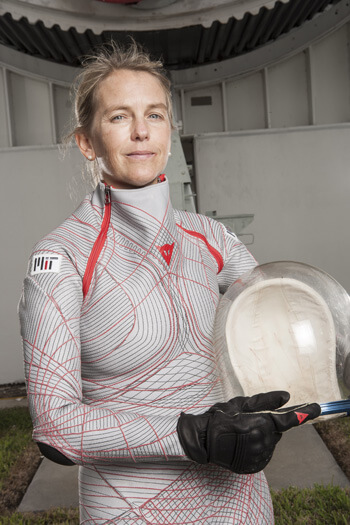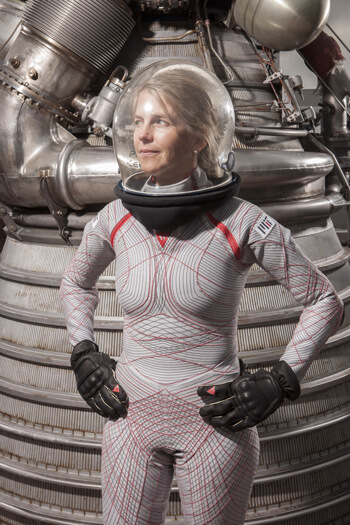Out of This World
Hanging by the door in Dava Newman’s office at NASA is the framed image of a boot print on Mars. Newman sees the orange-red imprint every morning when she arrives and every night when she leaves. It is a kind of icon, a symbol and a reminder, of her professional mission.
Getting humans to Mars is a major part of her job as Deputy Administrator of NASA. But for Newman, it’s been her lifelong passion as well. “My whole life has been dedicated to: How do we get astronauts to Mars?” Newman says. “That really has always been my passion. How do we get humans, for exploration, farther out into the solar system?”
The zeal for exploration started early for Newman, growing up in Montana. She took to the skies at a young age, flying with her pilot dad. And as a kid in Big Sky Country, she was inspired watching the Apollo program and the moon landings. “I’m from the Apollo generation,” Newman says, “Of just saying absolutely: exploration is what America does.”
But while the exploration seed was planted early, it wasn’t quite a straight path from gazing up at the Montana firmament to helping lead NASA. When Newman first got to Notre Dame as a freshman, she enrolled as pre-law. But by sophomore year she had realized her strengths were in math and science, and she switched to aerospace engineering.
Newman thrived at Notre Dame. Though most of her studies were focused on math and science, she loved philosophy and the identity of being a technical person who also embraced the liberal arts. She played on the basketball team and made lifelong friends – she spends a weekend with her basketball friends every year, and many members of the close-knit group even came out for her ceremonial swearing-in in Washington. (Back in her Notre Dame basketball days, slam-dunking was never something the petite Newman could do. “But on Mars? No problem. Big motivation,” she jokes.)
 Photos by Douglas Sonders
Photos by Douglas Sonders
After graduating from Notre Dame in 1986, Newman headed east to the Massachusetts Institute of Technology (MIT) for graduate school. In 1989 she earned master’s degrees in both aerospace engineering and in technology and policy, and in 1992 earned a Ph.D. in aerospace biomedical engineering. Her first faculty job took her to the University of Houston, but after a year she returned to MIT to join the faculty.
Newman loves to teach and, in addition to instructing graduate students, really wanted to teach freshmen. An introductory aerospace engineering book for freshmen didn’t exist, so she wrote one, Interactive Aerospace Engineering and Design, and taught a freshman class at MIT based on it. In the course of her research work at MIT, Newman sent four experiments to space investigating human performance in microgravity. She had a deep interest in how astronauts perform in different environments and how to maximize their performance in isolated and confined environments.
While at MIT, Newman’s passion for furthering exploration of the solar system led to her best-known creation: The Biosuit, a new type of spacesuit that could revolutionize how astronauts move in different states of gravity. The form-fitting suit is significantly lighter than traditional gas pressurized spacesuits, while providing increased mobility.
In Newman’s office stands a replica of an Apollo spacesuit. The suit is what anyone pictures when thinking of a spacesuit: A towering, bulky garment. The current suits weigh 140 kilos, Newman notes – weight that isn’t felt in space, but when some gravity is there, as on Mars, then the weight matters. With the Biosuit, the design goal is 20 kilos. “I was always trying to see, how can we reduce the mass and maximize mobility,” she explains. “I didn’t want people to move against the suit, I wanted the suit to facilitate your performance – not waste energy overcoming a stiff suit.”
She wrote the proposal for the Biosuit while on sabbatical, as she and her husband spent 18 months circumnavigating the world in their sailboat from 2002-2003. Newman, exploring the Earth’s vast oceans and far-flung islands, was inspired. “I think of exploration – whether it’s here on Earth, whether it’s the oceans, whether it’s getting to Mars – as the same problem. We have to be really efficient.”
After years of studying and working on helping astronauts adapt to the gravity in other environments, in 2014 Newman got the chance to advance the mission to Mars in a new way. It’s a dream job, but when the White House called in 2014 to gauge her interest the position, it seemed too good to be true.
“When the phone call came I thought it was a prank,” says Newman. “They say this is the White House calling, and you say ‘yeah, right.’” Once she determined it was no joke, Newman says it took her “a nanosecond” to decide she was interested in the job. Harkening back to the ideals of service instilled at Notre Dame, she felt that the opportunity to serve the country at a high level of government was a huge privilege. “It’s my whole life’s work,” she says. “So to come to NASA and serve the government, what an honor.”
After a six month nomination process, she was confirmed by the United States Senate in April of last year on an 87-0 vote. She humbly notes that it was an easier process than other nominees have in polarized Washington: “Everyone supports NASA, so the meetings and interactions went well.”
 Photos by Douglas Sonders
Photos by Douglas Sonders
“It’s been the best job in the world,” Newman enthuses. “Every day is busy and challenging and wonderful.” She has three main focus areas at NASA: A human-crewed journey to Mars in the 2030s, technology and innovation, and education and outreach. On that final priority, Newman is adamant about the need to change negative connotations around STEM (Science, Technology, Engineering, and Math) in order to recruit and develop the workforce.
Always the explorer, Newman now wants to empower and encourage explorers in the next generation. In light of her desire to change the conversation, Newman prefers a more inclusive acronym – she now refers to it as STEAMD, with the “A” standing for Arts and the “D” for Design. “I want everyone out there to think this is for them. It’s a few lucky astronauts, but my job is to make every little girl and boy think, you’re welcome, we need you, we need your talents,” she says. “Getting to Mars is for everybody.”